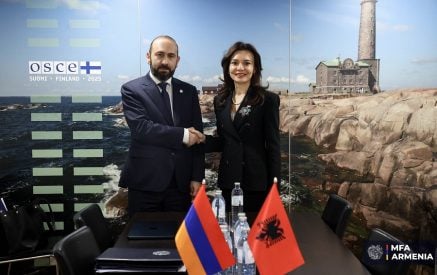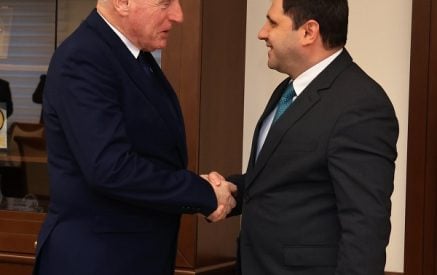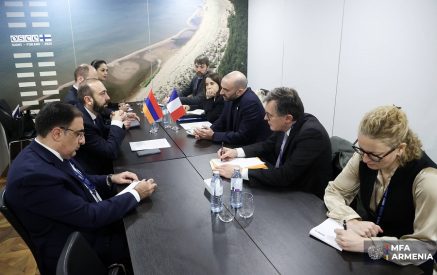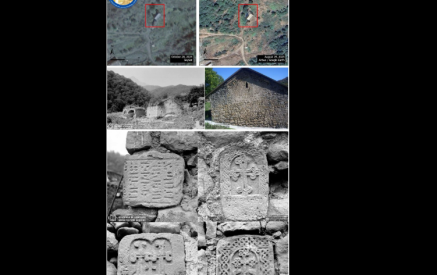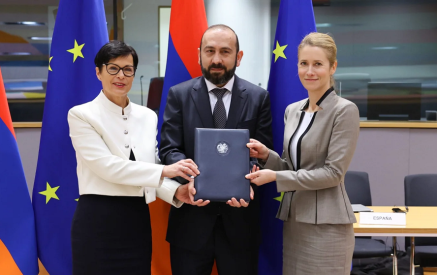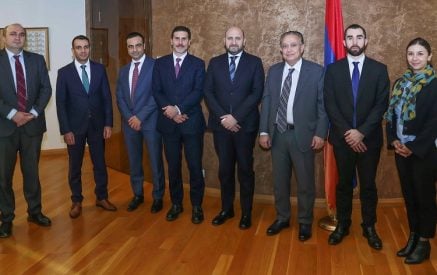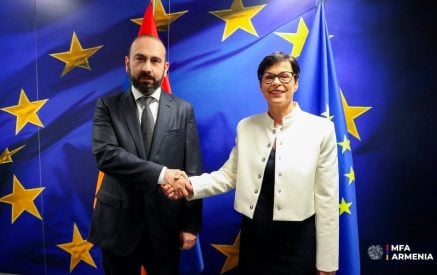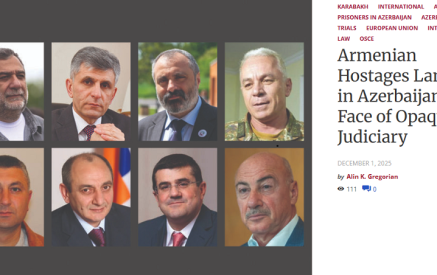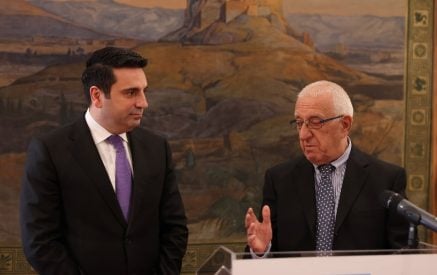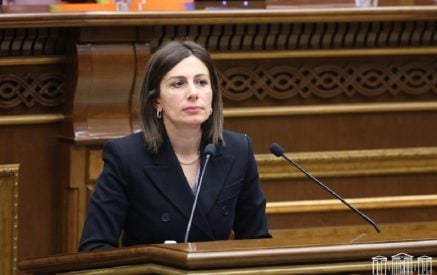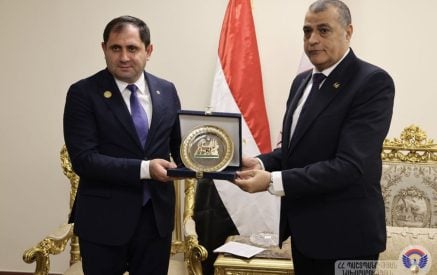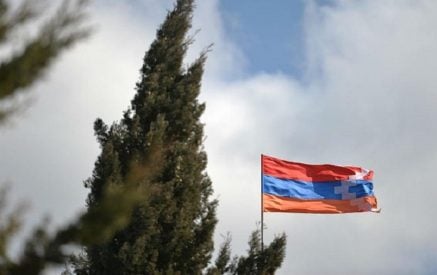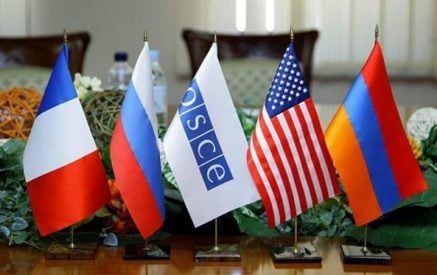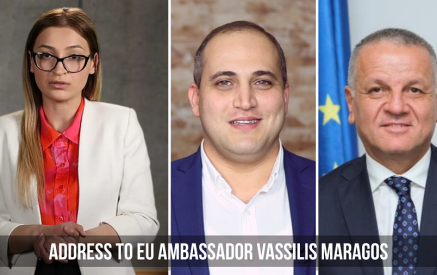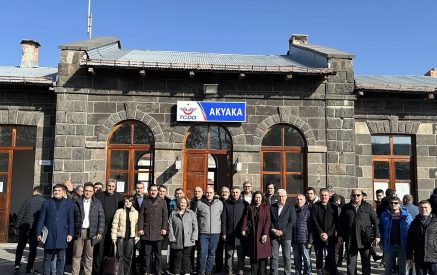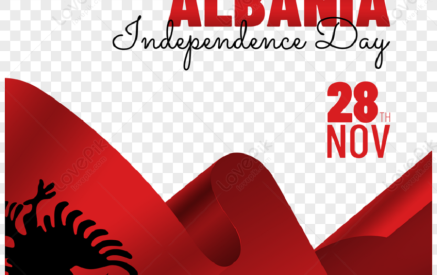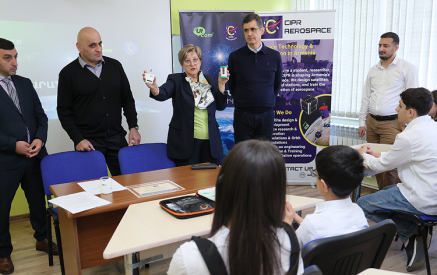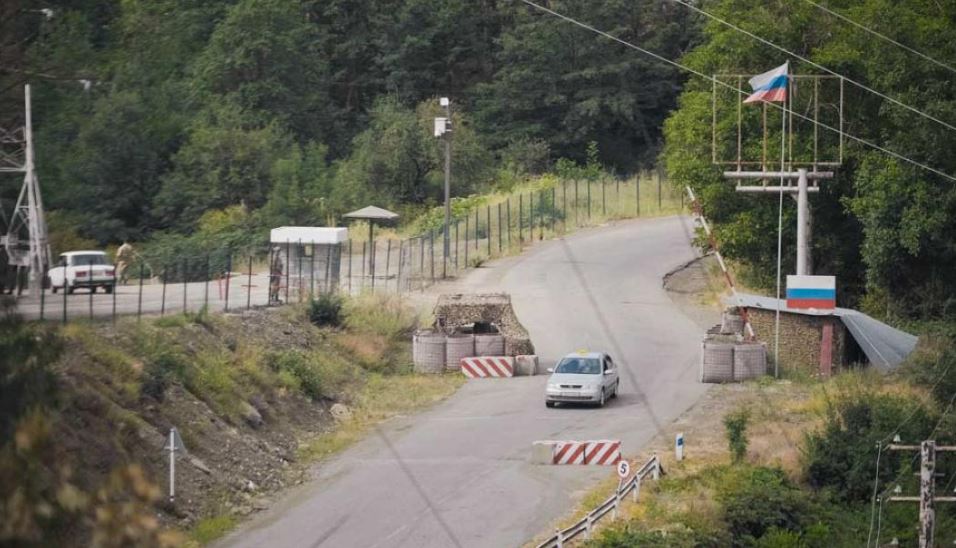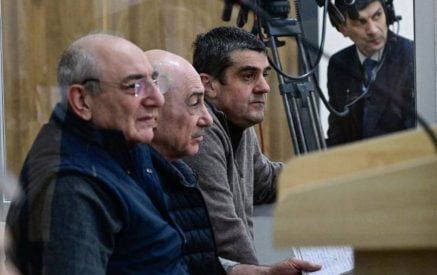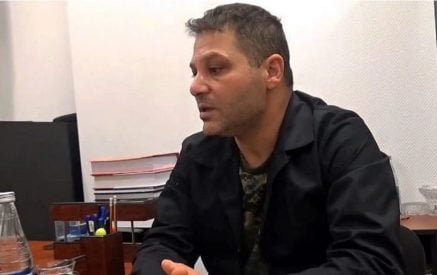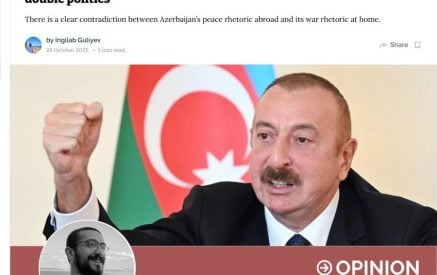Crisis Group’s new report
The European Union is sending monitors to Armenia’s border with Azerbaijan, so as to lessen the danger of renewed fighting between the two countries. Brussels must give the mission the means and mandate it will need to succeed.
What’s new? In January 2023, the EU announced a new mission to monitor the Armenia-Azerbaijan border. Fighting had flared there the previous September, though high-level diplomacy helped prevent it from expanding into full-scale war. But with peace talks faltering, and Baku in a stronger military position, the risk of renewed clashes remains high.
Why does it matter? A new war between Armenia and Azerbaijan would have tremendous human costs, undermine the EU, Russian and U.S. goal of de-escalating regional tensions, and sow further instability in an already volatile Eurasia. The new monitoring mission could help lower the risk.
Read also
What should be done? Brussels should endow its new two-year civilian monitoring mission with adequate resources as well as a flexible mandate to foster communication and cooperation between the parties. It should seek Baku’s cooperation for the mission, including cross-border access, and (if possible) let the mission’s staff liaise with Russian border guards.
Executive Summary
Two years after their second war over Nagorno-Karabakh, Armenia and Azerbaijan are uncomfortably close to starting a third. Over the course of 2022, even as mediators sought a comprehensive peace deal, three major bouts of fighting – the most recent in September – demonstrated the situation’s volatility. While the future of the mountainous Nagorno-Karabakh enclave remains at the core of the neighbours’ conflict, September’s fighting, which took place along the countries’ border and inside Armenia, expanded the battlefield. With Azerbaijan enjoying a greater military edge, and Russia distracted by the war in Ukraine, there is little to keep Baku from pressing its advantage along this new front should it grow impatient with talks. That could plunge the two countries back into war at significant human cost and to the detriment of the broader South Caucasus. The European Union’s (EU) new civilian monitoring mission to Armenia’s border with Azerbaijan is a bold and encouraging step to help mitigate the risks. The mission must be given the means and mandate to succeed.
Since the end of the Cold War, Armenia and Azerbaijan have been locked in a bitter conflict over Nagorno-Karabakh, which was part of Azerbaijan in Soviet times and is home to a majority ethnic Armenian population. Armenian troops took control of the enclave and seven adjoining regions by force in the early 1990s, and for nearly 30 years it has been ruled by de facto authorities seated in the city of Stepanakert. But in 2020, a six-week war, which killed more than 7,000 troops, saw Azerbaijan regain control of about one third of the Soviet-era Nagorno-Karabakh Autonomous Oblast and most of seven adjacent territories, while also demonstrating its superior military capabilities. Russia brokered a ceasefire agreement to end the war and also took steps to keep the peace. It inserted peacekeepers to constrain resurgent fighting in and around the enclave, and border guards on the Armenian side to keep the parties from fighting along the frontier. But the results have been uneven at best, as Baku has tested its newfound strength both at the negotiating table and on the battlefield.
Against this backdrop, the last year and a half of relations between Armenia and Azerbaijan have been marked by movement along two very different tracks. On one track, the parties have pursued a peace process, with an emboldened Baku eager for concessions and a wary Yerevan worried that it will be railroaded but hoping for benefits for its development agenda. The fate of Armenian-populated Nagorno-Karabakh remains the most substantial issue separating the parties: Yerevan demands special rights and protections for the enclave’s residents, while Baku insists that their status is a domestic matter inappropriate for bilateral discussions.
But there are other major issues, too. These include a dispute around several sections of the interstate border that were never fully demarcated at the end of the Cold War, and an argument over development of a transport corridor that would pass through southern Armenia and link Azerbaijan to its exclave, Nakhchivan, off Armenia’s western frontier. Still, the parties have made progress – at one point committing to reach an agreement to conclude a deal by the end of 2022 – though they failed to meet the deadline.
Even amid the negotiations, however, the neighbours’ relations have simultaneously hurtled down a more confrontational track. The last calendar year witnessed three major bouts of fighting between the parties, each bloodier than the last. The first two series of clashes, in March and August, enabled an increasingly confident Azerbaijan to improve its military position vis-à-vis Nagorno-Karabakh. But the most lethal and arguably most consequential round occurred along the two countries’ border in September. These hostilities saw Azerbaijan move troops into strategic positions inside Armenia itself that they still control. High-level diplomacy by Brussels, Washington, Moscow and others helped end the fighting, supported by separate short-term monitoring and assessment missions from the EU, the Organization for Security and Co-operation in Europe (OSCE) and the Russia-led Collective Security Treaty Organisation (CSTO). But those missions lapsed. Moreover, the diplomatic track stalled, in part because of Baku’s backing for activists blockading the road linking Armenia to Nagorno-Karabakh.
It is anyone’s guess whether or where fighting might next flare up, but the risk of a reprise of September’s hostilities – along roughly the same lines – is substantial. Enriched by its energy resources, Baku continues to gather military strength and confidence in its edge. Armenia, by contrast, has struggled to replenish its weapons stores following the 2020 conflict, with its traditional security partner, Russia, hoarding armaments for its conflict in Ukraine. Russian peacekeepers and border guards have not proven an effective deterrent: they were unable to stop Azerbaijani advances in the 2022 fighting and Moscow has made clear that it does not want to alienate Baku or its ally Ankara. From the high ground that they now control inside Armenia, Azerbaijani forces could sweep down to take more territory, which would cut off southern Armenia from the rest of the country and force Yerevan into more concessions. Some worry that if Baku grows frustrated with the pace of talks, it could well try its luck at exactly this manoeuvre.
Against this backdrop, the EU’s announcement on 23 January that it will deploy a new monitoring mission to Armenia in the border area comes as welcome news. This mission may well be the best way to keep the parties from returning to blows at the border and inside Armenia. In theory, the CSTO or the OSCE could also have done the job, but neither of them was acceptable to both parties. Yerevan expressed deep reservations about the CSTO’s proposal; notwithstanding its own membership in the alliance, it does not fully trust its fellow members to side with it against Baku. Baku rejected the ideas from the OSCE, which sponsored decades of failed mediation under the auspices of the so-called Minsk Group chaired by Russia, the U.S. and France, and which Azerbaijan treats as defunct.
With Armenia’s backing, the EU forged ahead, overcoming scepticism among member states, to make its 23 January announcement of a new two-year mission. Now, as Brussels prepares to deploy monitors, it will need to work out many operational details as well as turn its attention to eliciting Baku’s cooperation, absent which the mission will lack access both to Azerbaijani territory and to certain areas of the border zone that would be too dangerous to monitor without arrangements on both sides. It will also need to look for ways to coexist productively with the Russian presence at the border. Personnel must be empowered not only to share information with EU mediators, but also to build communications channels between the two sides, and if possible to exchange information with Russian border guards. Although Moscow will surely object to the mission, its interests in seeing de-escalation in the South Caucasus overlap with the EU’s, and it would do well to look at the 23 January announcement as an opportunity. Indeed, Russians in the area suggest that some quiet cooperation at the local level may be possible.
The threat of another war on a continent already struggling to cope with Russia’s war in Ukraine is all too real. Spring will soon reach the South Caucasus, with melting snows clearing the way for new operations. Brussels should move quickly to get its mission on the ground before new fighting breaks out – engaging in diplomacy to ensure that its staff have the freedom of movement, the cooperation of local actors and the mandate that will best help them prevent clashes with the potential to spiral into a wider conflagration.
I.Introduction
The past year was marked by both violent clashes and significant diplomacy between Azerbaijan and Armenia. While the two sides did not return to all-out war – which would have been the third between the South Caucasus neighbours since they both gained independence from the Soviet Union at the end of the Cold War – the geographic scope of the conflict expanded. In September, hostilities along the border led to the deployment of Azerbaijani troops deep into Armenia.
The crux of the conflict between the two neighbours continues to be Nagorno-Karabakh, a mountainous enclave most of whose residents are ethnic Armenian, and which is administered by de facto authorities in Stepanakert. Armenia and Azerbaijan have waged two wars over the enclave. In the first, fought in the early 1990s, Armenian troops gained control of Nagorno-Karabakh and seven surrounding territories. In the second, fought at the end of 2020, Azerbaijan reclaimed the latter territories as well parts of the enclave itself, demonstrating its growing military edge over its neighbour. Russia (which is a treaty ally of Armenia’s but has long played an important role as mediator between the parties) brokered a deal to end the 2020 conflict. To maintain a buffer between the parties, it inserted peacekeepers in the enclave, and guards along the Armenian side of the border between the two countries, which was never fully demarcated after Soviet dominion ended.
But the parties have clashed nonetheless, and the conflict’s footprint has grown larger. As discussed in greater detail below, there were three bouts of major fighting in 2022. The first two (in March and August) enabled an increasingly confident Azerbaijan to improve its military position vis-à-vis Nagorno-Karabakh. The third – which occurred over the course of two days in mid-September – saw Baku send troops over the border to take positions inside Armenia, where they remain. Although the latter development’s significance has been somewhat obscured by a blockade that Azerbaijani activists (with Baku’s backing) have imposed on the Lachin corridor linking Armenia to Nagorno-Karabakh, its potential to further destabilise an already unstable situation remains concerning. While clashes at the Azerbaijan-Armenia border have been a persistent feature of the countries’ tense bilateral relations for years, the presence of Azerbaijani troops inside Armenia adds a new issue for peace negotiations to address and another flashpoint between the two sides.
Against this backdrop, this report explores the evolving dynamics in the Armenia-Azerbaijan conflict with a particular focus on how they are playing out at the border and along the line separating the parties inside Armenia. It also offers recommendations for preventing fighting at the border from resuming and expanding through the introduction of an observer mission. It is based on dozens of interviews with Armenian, Azerbaijani, Russian and Western officials; diplomats based in Baku and Yerevan; various independent experts; and residents on both sides of the frontier. It builds on Crisis Group’s extensive research on the conflict between the two countries, including that relating to the situation in Nagorno-Karabakh.
II.A Relationship on Two Tracks
Following the 2020 war, relations between Azerbaijan and Armenia developed along two different tracks. On one, Baku sought to press the advantage that it had gained on the battlefield by pushing for negotiations toward a comprehensive settlement on favourable terms. On another, particularly over the course of 2022, the parties engaged in armed clashes through which Baku improved its position in and around Nagorno-Karabakh, and along and inside the border it shares with Armenia. By the end of the year, the peace track had stalled out, while the prospect of renewed fighting seemed all too real.
A.Peace Track
Following the end of hostilities in 2020, Baku quickly pressed for negotiations over a comprehensive peace deal, hoping that its battlefield success would strengthen its hand at the negotiating table. Shaky diplomacy around a comprehensive political settlement began roughly a year after the war. The Armenian and Azerbaijani foreign ministers met for the first time since the 2020 war for preliminary discussions in September 2021.2 Then, in February 2022, Baku formally invited Yerevan to enter into negotiations over a five-point proposal, which among other things aimed at mutual recognition of territorial integrity. This step would be followed by the institution of full diplomatic relations, which the neighbours have not enjoyed in the three-plus decades of tensions since the collapse of the Soviet Union.3 Armenia, still weak after its military defeat and believing that a peace deal would bring development opportunities, agreed, although it feared it would be compelled to make uncomfortable concessions.4
Moscow’s role as the primary mediator in the conflict (as well as Armenia’s main security partner) began to change during this period, as the European Union (EU) saw the opportunity it had long been seeking to ramp up its diplomacy in the aftermath of the 2020 war. Over the course of 2021, high-level EU officials paid several visits to Baku and Yerevan. In one notable if short-lived achievement in November 2021, Charles Michel, president of the European Council (the body comprising the heads of the EU member states), prevailed upon Baku and Yerevan to restore a communication channel between their respective defence ministries.5 A similar hotline had operated between the two capitals for almost a year from late 2018 to 2019, facilitating the calmest period on the front in over a decade.6 The new hotline had an even briefer lifespan; it petered out in early 2022.7
At first, the EU’s peacebuilding initiative – its most substantial in the Armenia-Azerbaijan conflict’s nearly 30-year history – seemed to have the Kremlin’s blessing. In December 2021, a month after the hotline’s inception, Brussels hosted the first-ever summit of the Armenian and Azerbaijani leaders. Russia did not object, believing that the meeting would help its own peace efforts.8
But Russia’s all-out invasion of Ukraine in February 2022 altered the diplomatic landscape, driving a wedge between Moscow and the West that manifested itself in new divisions over peacemaking efforts. The EU and Russia increasingly came to see their mediation efforts as competing. Two months after the invasion, in April, when Azerbaijani and Armenian leaders announced that they would begin formal peace talks at an EU-hosted meeting, Moscow accused Brussels of trying to oust it from South Caucasus diplomacy.9 In return, Moscow stopped participating in the Organization for Security and Co-operation in Europe (OSCE) Minsk Group, a forum co-chaired by Russia, the U.S. and France, which worked for a quarter-century to resolve the conflict over Nagorno-Karabakh, albeit with little success.10 As the EU forged ahead, Russian President Vladimir Putin’s regular phone calls with Michel to discuss the crisis fell by the wayside.11
With Baku in a hurry to make progress while both Russia and the West were distracted with Ukraine, talks moved fairly quickly. At an EU-convened summit in Brussels on 31 August, the two nations’ leaders agreed that their foreign ministers would meet within one month to work on draft texts of a prospective peace treaty.12 In the course of negotiations, the parties also agreed and publicly announced that they would wrap up a deal by the end of 2022.
The talks have been productive to some extent. The parties have come to a common position on the need to sign an accord on launching diplomatic relations.13 But they do not agree on other parts of the draft peace treaty – not even on what to call it.
The first and toughest outstanding issue remains the future of ethnic Armenians in Nagorno-Karabakh.14 Azerbaijan insists on a deal in which Armenia acknowledges Baku’s sovereignty over all territory within Azerbaijan’s internationally recognised borders, including the whole of Nagorno-Karabakh. Armenia has dropped its long-held opposition to that condition, but it wants Baku to agree to special security provisions and rights for Nagorno-Karabakh Armenians. Yerevan believes such provisions are necessary for them to safely make their lives in the enclave.15 Baku says Nagorno-Karabakh residents are entitled to the rights of Azerbaijani citizens, but no special status or privileges, and refuses to include what it deems a domestic question in formal bilateral discussions.16 Since mid-2022, the EU and U.S. have suggested to Baku that it might navigate this impasse through direct talks with de facto authorities in Stepanakert.17 Azerbaijan has indicated that, despite reservations, it will consider this option, although given the blockade (discussed below) there has been no progress in this direction.18
The second big issue – and one that has become more challenging over the course of the past year – is the border dispute between the two countries. The border has been a point of contention since 1991, when Armenia and Azerbaijan both gained independence upon the Soviet Union’s dissolution. The countries disagree about which maps to use as the basis for demarcating the frontier. Azerbaijan favours using a number of Soviet-era maps from different periods, while Armenia believes such an approach would hand Azerbaijan too large a claim over its present territory.19 The two parties agreed to discuss this topic at a Russia-mediated meeting in November 2021, but they have made little progress since.20
Now the issue has become even more complicated, with September’s outbreak of fighting along the border adding a new topic for negotiations: the withdrawal of Azerbaijani troops from positions they took on Armenian territory.21 Yerevan has proposed the mutual withdrawal of forces to spots several kilometres away from the current positions and a demilitarised zone along certain stretches of the border.22 But, as discussed below, Baku has little incentive to move its soldiers away from the strategically advantageous positions they have claimed. It says it will not order its soldiers to leave, arguing that absent border demarcation, it cannot be accused of occupying Armenian lands.23
The border fighting relates to a third topic on the bilateral agenda – the creation of a transport corridor through Armenia, which some have suggested was one of several motivations for Baku to send troops into Armenia in September.24 In the Russian-brokered ceasefire statement that the parties agreed to in November 2020, Armenia and Azerbaijan committed to reopening roads – and building new ones – to reconnect the region after decades of blockade.25
But the two sides have interpreted this commitment differently. Baku reads it as authorising the construction of a new road (which it calls Zangezur, after one of the historical names for the southern Armenian province the route would traverse) that would link Azerbaijan proper to its exclave Nakhchivan, which sits off Armenia’s south-western border.26 Baku further insists that Russian, not Armenian, personnel oversee security along this new route – replicating the arrangement for the Lachin corridor that links Armenia to Nagorno-Karabakh.27
Armenia strongly disagrees with Baku’s interpretation of this element of the ceasefire statement, arguing that the document discusses only the Lachin corridor and is silent about the route Azerbaijan calls Zangezur.28 Rather than building the Azerbaijan-Nakhchivan link in isolation, Yerevan instead calls for a network of routes to be opened simultaneously, which would connect it directly to both Türkiye and Azerbaijan. This step would end the transport and economic isolation Armenia has suffered for 30 years, since the first war over Nagorno-Karabakh.29 Armenia also opposes Baku’s demand that Russian border guards be the only ones responsible for security controls along the so called Zangezur route.
As the two sides struggle with these issues, both Russia and the EU continue to try to mediate, albeit in separate channels. Russia, which has developed a draft peace agreement, was able to bring the two countries’ leaders together in Sochi, in October 2022, but not to induce either of them to offer the concessions a peace deal would require.30 The EU – which has been supporting a separate process with foreign ministers meeting for bilateral talks on the draft developed by the parties themselves – has struggled with arranging meetings between the Azerbaijani and Armenian leaders and their associates.
By the close of 2022, the discussions in both channels had stalled. The parties’ self-imposed deadline to reach a comprehensive deal by year’s end came and went with no agreement.31 Nor is it clear how the parties will regain momentum on the diplomatic track. The sheer complexity and number of disagreements to overcome had already made clinching a peace deal in the near future a highly ambitious undertaking. Now, competition between Russia and the West over Ukraine has bled into peace efforts. New ground realities – and indeed animosity – in the wake of the September escalation and the blockade of Nagorno-Karabakh have cast an even bigger pall over talks. As talks falter, the likelihood of renewed fighting increases.
B.Conflict Track
Even as Baku pushed negotiations, the two sides clashed in the spring, summer and fall of 2022.32 By pursuing military gains even as its negotiators were discussing a political settlement, Azerbaijan appeared to be trying to put itself in the best possible position to win concessions from Armenia.33
As Crisis Group previously reported, the first major fighting came in March, when Azerbaijani forces seized territory around Farukh, an ethnic Armenian-populated village patrolled by Russian peacekeepers as part of the 2020 ceasefire. As a result, they were able to establish new positions in the nearby mountains. From their new vantage points, the Azerbaijani troops enjoy views deep into Armenian-populated areas – something that would work to their benefit in any future military campaign.34 Still, EU mediators were able to press forward on the diplomatic track, bringing the parties’ leaders together for a summit in Brussels in late April, and moving ahead with formal talks as noted above.
The second outbreak came in August. On 3 August, Baku launched a military operation in Nagorno-Karabakh, saying an Azerbaijani soldier had been killed in the Lachin region in an exchange of fire with forces of the de factor authorities in Stepanakert.35 Though bloodier than the March episode, the result was analogous. When the fighting had died down, Azerbaijani forces had gained strategically advantageous positions, and diplomacy soon resumed, culminating late in August in an EU-mediated summit between Armenian and Azerbaijani leaders in Brussels. Although no major announcement emerged, the discussions produced a commitment to start substantive talks on a peace treaty within a month.
Then came September’s escalation, which was the most serious bout of fighting since the 2020 war. The two days of hostilities beginning 13 September covered a much larger swathe of territory than previous escalations, with Azerbaijani forces driving deep into Armenia and artillery, mortar and drone attacks along a 200km stretch of border. When fighting halted, Azerbaijani troops had taken control of new positions deep inside Armenia, again improving the strategic map in their favour and positioning Baku better to push Yerevan into agreeing to a peace deal faster and on its terms.36
While talks resumed in the aftermath of the September fighting, they did not regain their prior momentum, in part because a new crisis on the ground created further acrimony between the sides. Azerbaijani state-backed activists who say they are protesting gold mining in Nagorno-Karabakh have blocked the Lachin corridor, which is the only road to the enclave from Armenia, leaving as many as 120,000 people there without medical and food supplies. Despite international pressure to open the corridor, Azerbaijani President Ilham Aliyev has praised those obstructing it, and the ostensible protest has been favourably and extensively covered by state-owned media.37
III.New Flashpoints
Azerbaijan’s 2020 victory and its gains in subsequent clashes underscore the extent to which it has gained the military upper hand over its neighbour, a reversal of the situation three decades earlier when Armenia gained control of Nagorno-Karabakh. The gains it made in September 2022 are particularly striking because of the way in which they have widened the conflict’s footprint. Azerbaijani soldiers have taken control of approximately 140 sq km inside Armenia itself.38 From their commanding positions, these soldiers have the capability to strike even further into the country, potentially cutting the southern part of Armenia off from the rest of the country in a matter of days. The newly lopsided balance of power increases the risk that, should talks fail to revive, Azerbaijan may be tempted to take what it can by force.
A.Baku Emboldened
The sources of Baku’s strength are several. Bolstered by income from the surge in prices of its energy exports amid Russia’s invasion of Ukraine, Azerbaijan has continued to build up its army, increasing budgets by some 40 per cent since 2020 and adding new commando units and other specialised forces.39 Baku’s forces are also now increasingly well equipped, with a diversified inventory that includes various cutting-edge weapons such as long-range surface-to-surface precision missiles, loitering weapon systems (which hover above targets), and combat drones supplied by Israel and Türkiye.40 Meanwhile, Baku continues to enjoy aid from Türkiye in the form of joint military drills and other technical and material support.41 An Azerbaijani military representative told Crisis Group that Ankara has long backed Baku’s operations, including that in September, by providing intelligence and other assistance.42 Heightened European demand for Azerbaijani gas has also emboldened Baku.
As Baku has grown more powerful, Armenia has weakened in both relative and absolute terms. Russia’s war in Ukraine has not only distracted it, and diminished its stature as an effective guarantor of the local peace, but has also reduced its capacity as a security partner to Armenia. Yerevan is short of weapons, its storehouses depleted by the 2020 war, but Moscow – its traditional supplier – is channelling arms to its own war in Ukraine.43 In the face of rising tensions, Yerevan has yet to identify a reliable new source of weapons that its soldiers would not require extensive training to use.44
Beyond weapons, the Armenian military is also struggling with upheaval in its command structure and poor morale within its ranks.45 In February 2021, Prime Minister Nikol Pashinyan, who has been at loggerheads with much of the top brass since they called for his resignation in 2021, fired the general staff chief and did not replace him for over a year.46
B.A Damoclean Sword
Azerbaijan benefits not only from the growing differential between its power and Armenia’s, but also from the field position it has staked out inside Armenia’s border as a result of the fighting in September. Armenia’s most vulnerable territory at present is near the southern resort town of Jermuk, one of its top three tourist attractions (see map). Following the September clashes, Azerbaijani troops now sit atop several nearby mountains. Most importantly, they control mountain positions 7km south of the town. These overlook an uninhabited gorge through which a road passes to the Nakhchivan exclave. Both local and foreign military experts familiar with the area told Crisis Group that Azerbaijani troops would probably need just two days to march through the gorge. They could then, in effect, cut off the southern region of Armenia, Syunik, from the rest of the country.47
Baku also now controls several heights in Gegharkunik region, from which its forces encircle the town of Vardenis and nearby villages.48 The new Armenian positions in these areas are almost all in the valley or foothills. Farther south, Azerbaijan also took mountaintops near Nerkin Khand village, overlooking the road that connects Kapan, the main town in Syunik, with settlements in the rugged gorge along the border.49 These new positions would clearly give Azerbaijan a leg up if fighting resumes.
Finally, Baku’s territorial gains since 2020 also bring Azerbaijani troops closer to Armenia’s only route to Nagorno-Karabakh, the Lachin corridor, which is controlled by Russian peacekeepers. Since 2020, Baku has regularly hinted that it might try to assert control of the corridor.50 President Aliyev’s undisguised support for the crowds currently blockading the route to the detriment of Nagorno-Karabakh’s civilian population compounds these concerns.
But although most experts agree that Armenia could not prevent Azerbaijan from making further gains on these or other fronts, they do not know whether that is, in fact, Baku’s plan.51 Azerbaijan knows that such a step would bring harsh criticism from foreign partners. Domestic audiences, too, might wonder whether an attack on Armenian territory is truly necessary, particularly if it proves costly in terms of casualties.52 The gains that Baku made in September came at a cost. It lost more than 80 soldiers that month, many from its elite special forces, the steepest death toll in the two years since the 2020 war.53 These losses led to uncharacteristic debate in a country where the public has historically supported the military nearly unconditionally.54 But whatever Baku decides to do, its increased capacity to assert itself along the foregoing lines gives it diplomatic leverage, a Damoclean sword to hold over its neighbour.55
C.Visible Dominance
The signs of Azerbaijan’s new dominance are hardly lost on the Armenian population. While Azerbaijani troops have not occupied any populated areas, their positions are in full view of some 200,000 Armenians living near the border in three Armenian provinces – Syunik, Gegharkunik and Vayots Dzor.56 Among these are Armenians who fled homes elsewhere due to fighting in 2020 or before. One settlement that was particularly affected is Sotk, a village of 1,000 people populated mainly by Armenian refugees from Ganja, in Azerbaijan, who fled rising ethnic tensions in the late 1980s.57 Local officials and foreign experts say about 40 per cent of homes in the village were destroyed in recent fighting, and an Armenian military base, as well as a Russian border guard base nearby, were also hit.58 Grigor, 34, said shells “fell like raindrops” around his house and garden, sending his family scurrying to safety in their pyjamas and slippers.59 (The Azerbaijani side of the border is largely unpopulated. While Baku plans to resettle the reclaimed territory with people displaced by war three decades ago, it estimates the project will take years.60)
Locals report that the area’s insecurity is stifling its economy. The above-referenced spa resort of Jermuk, farther south, was full when fighting flared up. Several shells, including alleged cluster bombs, hit hotels as officials evacuated tourists and most of the 3,500 residents.61 Kristina, 45, said she had gone to the park to collect healing water from the sulphur springs for which Jermuk is famous. “At the end of the summer, there shouldn’t be room for an apple to fall in this park”, she said. Instead, it was empty. Kristina feared the dead silence was an omen that visitors might never return. “If tourists stop visiting, … how will we survive?”62
IV.A New EU Mission
The EU’s welcome announcement of a new mission on 23 January was months in the making. September’s fighting highlighted the extent to which the border dispute enflames the conflict between the two countries, even as the conflict over Nagorno-Karabakh remains the key driver. It also made clear that the war’s larger footprint brings with it expanded risks for renewed escalation, which could launch the parties into a broader war. Thus, in the wake of the September fighting, the Moscow-headquartered Collective Security Treaty Organisation (CSTO), the OSCE and the EU all began exploring the feasibility of missions to reduce conflict risks by providing visibility and a buffer between the parties at the border. All three deployed teams with short-term mandates, albeit with different purposes. While, as discussed below, any of the three might have sponsored a more enduring presence, in the end the EU was the right choice for the job.
A.The CSTO Option: Yerevan’s Reservations
After fighting broke out in September, the CSTO – a security alliance made up of Armenia, Kazakhstan, Russia, Belarus, Kyrgyzstan and Tajikistan – was the first to consider moving a mission into place. Armenia held the organisation’s rotating chair when fighting broke out on 13 September, and Prime Minister Pashinyan immediately called for urgent consultations, as the organisation’s founding treaty provides for. As the fighting continued, the six post-Soviet member states’ leaders met online and deployed a team of unarmed military experts to Armenia.63 These experts spoke to Armenian officials, Russian border guards and other military personnel based in the border zone.64
The CSTO also discussed a larger peacekeeping deployment on the Armenian side of the border.65 But the plan was put on hold because of Yerevan’s reluctance. Crisis Group’s research indicates that Armenian officials worried that a CSTO deployment would end up favouring their adversary, perhaps because the alliance did not appear to line up solidly behind Yerevan.66 Belarus was the most blatant on this front: President Aliaksandr Lukashenka accused Yerevan of trying to drag the alliance into war with Azerbaijan, which “is led by absolutely our kind of person – Ilham Aliyev”.67 Russian officials have also indicated both in meetings with Armenian counterparts and publicly that they cannot oppose Baku on the border issue because the line is not fully demarcated – a position that Armenian officials say echoes Baku’s talking points.68 The deeper reason may have more to do with Moscow’s fears of damaging diplomatic and commercial ties with Baku and its ally Ankara, as well as its concerns about having to redeploy military resources tied up in Ukraine to the South Caucasus.69
Toward the end of 2022, Russia continued to say it was ready to go ahead with a CSTO mission, but the prevailing attitude in Yerevan remained sceptical.70 Russian and Armenian officials told Crisis Group that the CSTO’s plan calls for a force made up mostly of Russians and Belarussians.71 The peacekeepers would be armed, but only for self-defence, and would not have a mandate to protect civilians, only to conduct monitoring along the ceasefire line. Russian officials have argued that the mission would not need a UN mandate because Armenia is a CSTO member and troops would deploy only with its consent.72
In Yerevan, opponents complained that the proposed CSTO mission would be almost identical to the peacekeeping mission Russia has had in Nagorno-Karabakh since 2020.73 This mission, while stabilising at first, has become less valuable following the full-scale Russian invasion of Ukraine, with Azerbaijan repeatedly testing the peacekeepers’ resolve. Russian troops have taken little or no effective action to defuse tensions when they have flared.74 Armenia also fears that accepting the CSTO proposal would look like taking Russia’s side in the standoff with the West over Ukraine. Yerevan would much prefer to maintain ties with both Moscow and its adversaries as it seeks international backing for its complaint that Azerbaijan is occupying Armenian territory.75
The EU announcement makes it still less likely that the CSTO would send its own mission to the area, but the odds were steeply against it even before Brussels made clear its plans. As a Russian expert put it, Moscow seems unwilling to risk a military deployment Azerbaijan might view as lending “support to their enemy”, while Armenia is uninterested in hosting troops that it worries might harbour sympathies for its adversary.76 Under sufficient pressure, Armenia might be persuaded by Russia to drop its deep reservations. But, in such a case, Yerevan’s concerns would likely mean that it is a less than cooperative host, undermining the mission’s ability to fulfil its mandate on the ground.
B.The OSCE Option: Baku’s Objections
Another option that regional powers discussed would be for the OSCE – a regional security organisation that includes all of the relevant actors (among them, the conflict parties, Russia, and the EU member states) – to send a mission. In late October, the OSCE deployed a week-long conflict assessment mission to Armenia at Yerevan’s request. But a longer-term OSCE mission would be unacceptable to Baku.
The idea of a longer-term OSCE mission had support, most notably, in the United States and France.77 Because the OSCE brings together all of the major European actors, French officials said they saw a larger OSCE role as a way to avoid the tension between Western states and Moscow that an EU mission might engender.78 One French diplomat noted that if Moscow looked askance at such a mission, Armenia would suffer. In the event of new fighting, the diplomat noted, “weak Armenia will have to respond all alone. Because we will not be able to [protect it]”.79 U.S. officials, for their part, sought a way to ensure broad international engagement while avoiding a direct role for their own country. “There will be no [U.S.] boots on the ground”, a U.S. official underscored.80
But Baku voiced its opposition in categorical terms. The OSCE’s decades-long role in mediating between Armenia and Azerbaijan through the Minsk Group and other channels was upended by the 2020 war, and Baku has been critical of the process as failing to resolve the conflict, a view that hardened after its recent military success. It has suggested that it views the organisation’s mediation efforts as a thing of the past and that there is little reason to believe it can play a useful role in normalisation efforts between Baku and Yerevan.81 Baku also protested the OSCE’s October assessment mission, asserting that the deployment violated the organisation’s consensus principles (although the OSCE does not require unanimous consent to dispatch a mission) and signalled its displeasure by boycotting the discussions of the 2023 OSCE budget, which requires unanimous support to pass.82 Within the OSCE, Ankara backed Baku’s criticism, although it did not join the budget discussion boycott.83 Against this backdrop, a broader OSCE mission did not seem in the cards, even before the EU’s 23 January announcement.
C.The EU Option: Building Momentum
Given Yerevan’s reservations about the CSTO and Baku’s about the OSCE, an EU mission was always the most promising option. The two-year deployment that Brussels commendably announced on 23 January will build on the work of its earlier short-term observation mission, which it agreed to deploy after the October meeting of the Armenian and Azerbaijani leaders on the sidelines of the EU summit in Prague.84 On 20 October, about a month after the escalation at the border, some 40 unarmed EU observers arrived on the Armenian side of the line. Their two-month mandate was to patrol some 250km, thus contributing to the “restoration of peace and security in the area” and “building of confidence” between the two sides.85
The 2022 mission came together rapidly and was limited in scope, although with 40 personnel it was bigger than the CSTO and OSCE deployments and also played a more substantial role. Its staff, vehicles and equipment came from another EU monitoring mission, the one in neighbouring Georgia.86 Its movements were confined to the Armenian side of the border, as Azerbaijan refused them entry. Due to security concerns, the observers could not travel without giving their itinerary to both Armenian and Azerbaijani authorities in advance.87 Armenian soldiers were asked to escort them everywhere they went.88
A week before the mission wrapped up in December, Brussels began laying the groundwork for a bolder, longer-term EU mission by deploying another small team of technical experts to make preparations in Armenia.89 EU diplomats started preliminary talks with Azerbaijani officials, but these were disrupted by the crisis over the blockade of the Lachin corridor. “We are expected to put pressure on Baku to solve the Lachin crisis, but this makes it even more difficult for us to soften Baku in the negotiations about the mission”, an EU diplomat involved in negotiations told Crisis Group.90
Even as EU diplomats sought acceptance of the proposed mission with regional leaders, EU officials worked to overcome reservations in Brussels.91 Some European officials have told Crisis Group that they believed the EU should concentrate its resources on the war in Ukraine and not elsewhere.92 Others questioned whether the EU should deploy monitors to Armenia, a country militarily allied through the CSTO with Russia, which should in theory bear responsibility for its security.93 Some EU member states seemed wary of going ahead with a mission absent Azerbaijan’s agreement. As one diplomat put it: “If we send a mission only to the Armenian side without Baku’s consent, it may create the wrong impression. … Baku may see it as ‘the EU is against it’.”94 Some worried about how alienating Azerbaijan, a major energy exporter, would affect their economic interests.95 Late in 2022, Armenia began reaching out to some of Baku’s biggest EU trade partners, particularly Hungary, Italy and Romania, to discuss the mission.96
While Baku has expressed reservations, it has not rejected it outright as it did the OSCE’s proposal. Azerbaijan’s foreign ministry warned “an EU mission in Armenia duly takes into account the legitimate interests of Azerbaijan”, criticising the EU’s fall monitoring mission for not adequately doing so.97
In the event, anxieties about another war breaking out in the EU’s backyard seem to have trumped the other concerns, and the EU announced its new two-year mission on 23 January. While much remains to be fleshed out on the new mission, it aims (in the EU’s own words) to “contribute to stability in the border areas”, “build confidence” and “ensure an environment conducive” to peace talks.98 These goals are ambitious but appropriate. Providing the EU deeper and more immediate knowledge of the situation on the ground may alert it to building tensions, helping position it for timely diplomatic engagement, and would also enhance its mediation efforts.
But there are major questions and issues that remain to be addressed. A central one is where the new EU observers would be permitted to go. Armenia is prepared to offer them unrestricted access, but in order to report accurately on security incidents, they would require the same on the Azerbaijani side. Baku, however, is unconvinced. Azerbaijani officials draw parallels with the Russian peacekeeping mission in Nagorno-Karabakh, which Baku sees as an infringement on its sovereignty and territorial integrity, and wants to see leave.99
One possibility is that Baku could agree to a new EU mission, but that it would enjoy access only on the Armenian side. If Azerbaijan does not allow monitors cross-border access, it would be suboptimal from both a deterrence and awareness standpoint. In addition to being confined to Armenian territory, absent an arrangement with Baku, the mission would have to steer clear of border areas that could be dangerous. But the mission could still be beneficial, especially if Azerbaijan supports official contacts with monitors. Still, influential actors such as the U.S. should work through their channels to Baku to encourage full cooperation with the mission, including access to its side of the border.
Another question is whether Russia will cooperate. In December, Russian officials declined to comment on the EU proposal, stressing only that they consider any EU involvement as aimed at pushing Russia out of the South Caucasus.100 Russian diplomats describe this position, which they say will only harden further, as related to the EU’s military support for Ukraine.101 A Russian diplomatic expert explained: “The Kremlin increasingly believes that Moscow should refuse to cooperate with those countries and institutions that assist Ukraine militarily and impose sanctions against Russia, because it will be perceived as validation of their hostile policies against Russia”.102 That said, Moscow does engage with EU missions elsewhere, including in Georgia, where Russian border guards control lines of separation in two conflict zones monitored by the EU unarmed observers.
Mission developers should – to the extent Moscow and Yerevan permit it – similarly plan for possible communications between EU monitors and the Russian border guards and military personnel deployed on the Armenian side since 2020, a mission separate from that of Russian peacekeepers in Nagorno-Karabakh and undertaken in accordance with bilateral treaties.103 Contacts between these guards and the EU monitors could allow for the exchange of useful information, avoid tensions and prevent misunderstandings. In October, before the EU’s short-term mission arrived, Russian officials said such contacts would make sense. Yet thus far, Russian forces reportedly have talked to the EU monitors who deployed part of the short-term December mission only through Armenian officials.104 Moscow should rethink its approach, weighing the potential benefits of direct ties for clearer communications in support of its own efforts to prevent new escalations in areas where its border guards and soldiers are stationed.
A third and final issue relates to the mission’s mandate and funding. Even with full cooperation from all the relevant actors, the mission could fail if it is poorly funded or confined by an overly circumscribed mandate. Beyond monitoring, and registering incidents, mission participants should be empowered to be proactive in facilitating dialogue among those posted at locales along the border if that might serve to prevent and mitigate violence. In the words of an EU member state representative who strongly supports the mission: “They should have a chance to facilitate cooperation”.105
Past experience offers lessons about how a mission might be of greatest use. The EU civilian mission in Georgia has facilitated communications between Tbilisi and its breakaway regions of South Ossetia and Abkhazia. It supported the institution of a “hotline” connecting relevant officials responsible for security along the lines of separation in conflict zones. It also facilitated face-to-face meetings between them.106 Similar efforts could be useful at the Armenia-Azerbaijan border. Regular meetings of military, police and border force representatives could help prevent security incidents arising from incomplete information on one or the other side, or from misunderstandings. As an added benefit, mission members could encourage meetings among local officials to discuss sharing water for drinking and irrigation, as well as ecological problems that have plagued residents on both sides of the border for decades.107
V.Conclusion
While there are a number of flashpoints between Armenia and Azerbaijan, September’s fighting along the border and inside Armenia has amplified the risk that hostilities will break out along this front. Should that lead to another war in the South Caucasus, both countries would face human, financial and political costs, and regional stability would suffer as well. Even short of all-out war, fresh fighting would bring nothing but misery to residents and further sour the political atmosphere in Eurasia, which is already quite poor due to Russia’s actions in Ukraine. But with negotiations shaky, and diplomacy complicated by the deepening crisis between Russia and the West, the parties’ neighbours will need to invest added effort and energy in order to help manage the risk of renewed hostilities.
The 23 January announcement of a two-year EU mission was a bold and welcome step. Building member state consensus required some manoeuvring in Brussels, given Armenia’s formal alliance with Russia, and wariness of alienating Azerbaijan at a moment when its energy resources are in high demand across the continent. Still, the costs and risks appear manageable and well worth taking: the EU’s mission appears to offer the best chance of minimising the risk of a reprise – or an expansion – of September’s fighting.
It is now up to Brussels and its partners to make the most of the assignment that it has given itself. The EU will need to reach out through all feasible channels to win Baku’s buy-in and seek permission to deploy on the Azerbaijani side of the border. It will need to establish working arrangements with Russian border guards that borrow from the example set in other areas where EU monitors and Russian personnel work in close quarters. Finally, it will need to ensure that the mission has the requisite mandate and resources – including a broad writ to foster communication and cooperation both between the two parties and in locales along the border. Moscow may not welcome the mission with open arms, but its interests in the South Caucasus overlap with those of Brussels, at least as far as conflict prevention is concerned. The Kremlin should look at the mission as an opportunity and quietly help it do its job.
With Russia busy in Ukraine, the EU has over the past two years taken on a major role in mediating between Armenia and Azerbaijan, and for good reason: success in helping stabilise the South Caucasus would pay dividends economically, including by easing the challenges of energy trade with Azerbaijan, and strategically, as the bloc hardly needs more war near its borders. But these diplomatic efforts will come to naught if the parties keep falling back into ever deadlier armed confrontations. With its 23 January announcement of a two-year monitoring mission, Brussels showed that it has the political will to take on a new and crucial role in helping keep the parties from relapsing into conflict. Now it will need to give this mission the mandate, diplomatic support and resources that will allow it to succeed.
Yerevan/Tbilisi/Baku/Washington/Brussels, 30 January 2023





